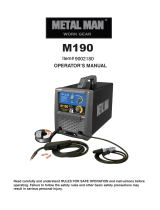
9 Stand correctly keeping a good footing and balance, ensure the floor is not slippery and wear non-slip shoes.
8 DO NOT operate the welder if it or the cables are damaged and DO NOT attempt to fit any unapproved torches or other components
to the welder.
8 DO NOT get welder wet or use in damp or wet locations or areas where there is condensation.
▲ DANGER! DO NOT weld near flammable solids, liquids or gases and DO NOT weld containers or pipes which have held flammable
materials. Avoid welding materials which have been cleaned with chlorinated solvents or welding near such solvents.
8 DO NOT stand welder on a metal workbench, car bodywork or similar.
8 DO NOT touch any live metal parts of the torch or electrode while the machine is switched on.
8 DO NOT pull the welder by the cable, or the torch. Protect cables from sharp or abrasive items, DO NOT bend, strain or stand on
cables or leads. Protect from heat. Long lengths of slack must be gathered and neatly coiled. DO NOT place cables where
they endanger others.
8 DO NOT touch the torch or workpiece immediately after welding as they will be very hot. Allow to cool.
8 DO NOT operate welder while under the influence of drugs, alcohol or intoxicating medication, or if tired.
9 When not in use store the welder in a safe, dry, childproof area.
1.3. GAS SAFETY
9 Store gas cylinders in a vertical position only and ensure the storage area is correctly secured.
8 DO NOT store gas cylinders in areas where the temperature may exceed 50°C. DO NOT use direct heat on a cylinder. Always keep
gas cylinders cool.
8 DO NOT attempt to repair or modify any part of a gas cylinder or valve and DO NOT puncture or damage a cylinder.
8 DO NOT obscure or remove any official labels on a cylinder. Always check the gas identity before use. Avoid getting gas cylinders oily
or greasy.
8 DO NOT lift a cylinder by the cap, guard or valve. Always keep caps and guards in place and close valve when not in use.
2. INTRODUCTION
Features heavy-duty high output transformer and forced-air cooling to ensure the highest level of performance. Contoured grip, non-live torch
ensures a steadier weld bead. Includes mini gas regulator, spool of wire, contact tips 0.6 and 0.8mm and gas cup. Suitable for welding with
CO2, Argon or CO2/Argon mix.
3. SPECIFICATION
Welding Current: ..........................................................................................................30-130A
Wire Capacity: ...............................................................................................................0.7-5kg
Duty Cycle: ............................................ 100% @ 30A, 60% @ 45A, 40% @ 65A, 20% @ 80A
Cooling System: ........................................................................................................Forced Air
Spot Welding Timer: ............................................................................................................. No
Gas Type: ..................................................................................... CO2, Argon, CO2/Argon Mix
Torch: ....................................................................................................................2m Non-Live
Supply: ............................................................................................................................. 230V
Absorbed Power: .............................................................................................................2.8kW
Case Size: ...................................................................................................................Compact
4. ASSEMBLY
4.1. CONNECTING THE GAS CYLINDER (See Section 5.3 regarding gas types)
4.1.1. If the gas cylinder belt is not supplied fitted, thread it through the metal loops in the back
panel just below the handle. Place the lower end of the cylinder into the metal hoop and
fasten the belt around the cylinder as shown in fig.2.
4.1.2. Ensure that the regulator (fig.1) is closed (knob turned fully clockwise) and then screw it
onto the cylinder (finger tight only). Once the regulator has opened the cylinder valve,
indicated by the sound of gas escaping, screw it one full turn further, which is sufficient to
seal the cylinder.
WARNING! Excessive tightening of the regulator will over-compress the sealing washer
and allow the gas to leak.
4.1.3. Push the gas tube into the quick connector on the regulator ( to remove tube, press collet in
and pull the tube. (See fig.1). Leave the regulator closed until the welder is fully set up and
you are ready to weld.
4.1.4. When you are ready to commence welding switch the machine on and turn the regulator
knob halfway for approx. 2l/min, and all the way for a max. flow of approx. 4l/min.
4.1.5. Always remove the flow regulator after use if the machine is to be stored for some time.
4.2. FITTING THE WIRE REEL. The welder is supplied with a mini spool of mild steel wire, but
will accept spools of up to 5kg without modification.
4.2.1. Referring to g.3, rotate the pressure knob (F) anti-clockwise and remove it from the
threaded spindle together with the spring (E) and the top disc (D). Small reels of
wire will run on the spindle itself. The larger 5kg wire reel will run on the larger diameter
ange at the base of the reel spindle (A). Place the wire reel (C) onto the spindle
ensuring that the wire withdraws from the top of the spool in a forwards direction towards
the wire feed unit. Place the plastic top disc (D) over the end of the spindle followed by
the reel spring (E). Thread the pressure knob (F) onto the end of the spindle and screw it
down clockwise until the spring is partially compressed. The reel take off pressure should be set to provide a mild braking effect to
prevent overrun where loose coils of wire form on the reel. DO NOT overtighten this knob as too much braking will conict with the
wire tension set on the wire drive unit.
4.2.2. Unscrew the wire feed pressure knob and lift the wire feed lever up to the right (fig. 4).
4.2.3. Straighten about 40-50mm of spool wire (DO NOT allow wire to uncoil) and check that the wire end is smooth and free from burrs.
g.1
g.2
Original Language Version
© Jack Sealey Limited Supermig130.V2 Issue 1 11/07/22






